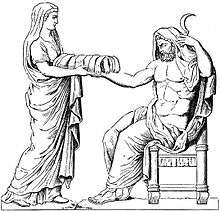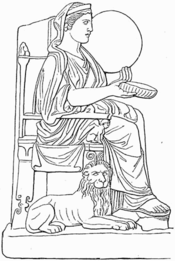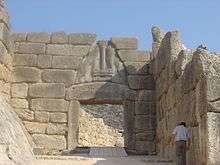Rhea (mythology)
| Rhea | |
|---|---|
 Rhea presenting Cronus the stone wrapped in cloth. | |
| Consort | Cronus |
| Parents | Uranus and Gaia |
| Siblings |
|
| Children | Poseidon, Hades, Demeter, Hestia, Hera, Zeus |
| Roman equivalent | Ops |

Rhea (/ˈriːə/; Greek: Ῥέα, Greek pronunciation: [r̥é.a͜a]) is the Titaness daughter of the earth goddess Gaia and the sky god Uranus, in Greek mythology and sister and wife to Cronus. In early traditions, she is known as "the mother of gods" and therefore is strongly associated with Gaia and Cybele, who have similar functions. The classical Greeks saw her as the mother of the Olympian gods and goddesses, but not as an Olympian goddess in her own right. The Romans identified her with Magna Mater (their form of Cybele), and the Goddess Ops.
| Look up Rhea in Wiktionary, the free dictionary. |
Etymology and namesakes
Most ancient etymologists derived Rhea ('Ρέα) by metathesis from έρα "ground",[1] although a tradition embodied in Plato[2] and in Chrysippus[3] connected the word with ῥέω (rheo), "flow", "discharge",[4] which is what LSJ supports.[5] Alternatively, the name Rhea may be connected with words for the pomegranate, ῥόα, later ῥοιά.
The name Rhea may ultimately derive from a pre-Greek or Minoan source.[6][7][8]
The name of the bird species rhea is derived from the goddess name Rhea.[9]
The second largest moon of the planet Saturn is named after her.
Myths and genealogy
| Greek deities series |
|---|
| Titans |
|
Cronus sired six children by Rhea: Hestia, Hades, Demeter, Poseidon, Hera, and Zeus in that order. He swallowed them all except Zeus as soon as they were born, because he had learned from Gaia and Uranus that, as he had overthrown his own father, he was destined to be overcome by his own child. When Zeus was about to be born, however, Rhea sought Uranus and Gaia to devise a plan to save him, so that Cronus would get his retribution for his acts against Uranus and his own children. Rhea gave birth to Zeus in Crete, handing Cronus a stone wrapped in swaddling clothes, which he promptly swallowed.
Then she hid Zeus in a cave on Mount Ida in Crete. According to varying versions of the story:
- he was then raised by Gaia;
- he was suckled by his first cousin, a goat named Amalthea, while a company of Kouretes, soldiers, or smaller gods, shouted and clashed their swords together to make noise so that Cronus would not hear the baby's cry;
- he was raised by a nymph named Adamanthea, who fed him goat milk. Since Cronus ruled over the earth, the heavens, and the sea, Adamanthea hid him by dangling him on a rope from a tree so he was suspended between earth, sea, and sky and thus, invisible to his father.
Zeus forced Cronus to disgorge the other children in the reverse order in which they had been swallowed, the oldest becoming the last, and youngest: first the stone, which was set down at Pytho under the glens of Parnassus to be a sign to mortal men, then the rest. In some versions, Metis gave Cronus an emetic to force him to disgorge the babies, or Zeus cut Cronus' stomach open. Then Zeus released the brothers of Cronus, the Gigantes, the Hecatonkheires, and the Cyclopes, who gave him thunder and lightning, which had previously been hidden by Gaia. Zeus and his siblings, together with the Gigantes, Hecatonkheires, and Cyclopes, overthrew Cronus and the other Titans. Similarly, in later myths, Zeus would swallow Metis when she was pregnant with Athena, because of a prophecy that said she would later give birth to one who would be more glorious than the father. Athena was born unharmed, bursting out of his head in full armor.
Cult
Rhea had "no strong local cult or identifiable activity under her control".[10] She was originally worshiped in the island of Crete, where according to myth, she saved the new-born Zeus from being devoured by Cronus, by substituting a stone for the infant god and entrusting him to the care of her attendants, the Curetes. These attendants afterward became the bodyguard of Zeus and the priests of Rhea. Their rhythmic, raucous chants and dances, accompanied by the tympanon (a wide, handheld drum) and the clashing of bronze shields and cymbals, provoked a state of religious ecstasy.[10] This may have been the source for the use of a tympanon in Cybele's rites; in historical times, the resemblances between the two goddesses were so marked that some Greeks regarded Cybele as their own Rhea, who had deserted her original home on Mount Ida in Crete and fled to Mount Ida in the wilds of Phrygia to escape Cronus.[11] A reverse view was expressed by Virgil,[12] and it is probably true that cultural contacts with the mainland brought Cybele to Crete, where she was transformed into Rhea or identified with an existing local goddess and her rites.
Iconography
Rhea only appears in Greek art from the fourth century BC, when her iconography draws on that of Cybele; the two therefore, often are indistinguishable;[13] both can be shown on a throne flanked by lions, riding a lion, or on a chariot drawn by two lions. In Roman religion, her counterpart Cybele was Magna Mater deorum Idaea, who was brought to Rome and was identified in Roman mythology as an ancestral Trojan deity. On a functional level, Rhea was thought equivalent to Roman Ops or Opis.
Most often Rhea's symbol is a pair of lions, the ones that pulled her celestial chariot and were seen often, rampant, one on either side of the gateways through the walls to many cities in the ancient world. The one at Mycenae is most characteristic, with a lioness placed on either side of a pillar that symbolizes the goddess (as seen in numerous images for goddesses throughout the ancient world where a tree or a column is used to represent the deity).
Depiction in ancient literature

In Homer, Rhea is the mother of the gods, although not a universal mother like Cybele, the Phrygian Great Mother, with whom she was later identified.
In the Argonautica by Apollonius of Rhodes, the fusion of Rhea and Phrygian Cybele is complete. "Upon the Mother depend the winds, the ocean, the whole earth beneath the snowy seat of Olympus; whenever she leaves the mountains and climbs to the great vault of heaven, Zeus himself, the son of Cronus, makes way, and all the other immortal gods likewise make way for the dread goddess," the seer Mopsus tells Jason in Argonautica; Jason climbed to the sanctuary high on Mount Dindymon to offer sacrifice and libations to placate the goddess, so that the Argonauts might continue on their way. For her temenos they wrought an image of the goddess, a xoanon, from a vine-stump. There "they called upon the mother of Dindymon, mistress of all, the dweller in Phrygia, and with her Titias and Kyllenos who alone of the many Cretan Daktyls of Ida are called 'guiders of destiny' and 'those who sit beside the Idaean Mother'." They leapt and danced in their armour: "For this reason the Phrygians still worship Rhea with tambourines and drums".[14]
Rhea's descendants
| Descendants of Cronus and Rhea [15] | ||||||||||||||||||||||||||||||||||||||||||||||||||||||||||||||||||||||||||||||||||||||||||||||||||||||||||||||||||||||||||||||||||||||||||||||||||||||||||||||||||||||||||||||||||||||||||||||||||||||||||||||||||||||||||||||||||||||||||||||||||||||||||||||||||||||||||||||||||||||||||||||||||||||||||||||||||||||||||||||||||||||||||||||||||||||||||||||||||||||||||||||||||||||||||||||||||||||||||||||||||||||||||||||||||||||||||||||||||||||||||||||||||||||||||||||||||||||||||||||||||||||||||||||||||||||||||||||||||||||||||||||||||||||||||||||||||||||||||||||||||||||||||||||||||||||||||||||||||||||||||||||||||||||||||||||||||||||||||||||||||||||||||||||||||||||||||||||||||||||||||||||||||||||||||||||||||||||||||||||||||||||||||||||||||||||||||||||||||||||||||||||||||||||||||||||||||||||||||||||||||||||||||||||||||||||||||||||||||||||||||||||||||||||||||
|---|---|---|---|---|---|---|---|---|---|---|---|---|---|---|---|---|---|---|---|---|---|---|---|---|---|---|---|---|---|---|---|---|---|---|---|---|---|---|---|---|---|---|---|---|---|---|---|---|---|---|---|---|---|---|---|---|---|---|---|---|---|---|---|---|---|---|---|---|---|---|---|---|---|---|---|---|---|---|---|---|---|---|---|---|---|---|---|---|---|---|---|---|---|---|---|---|---|---|---|---|---|---|---|---|---|---|---|---|---|---|---|---|---|---|---|---|---|---|---|---|---|---|---|---|---|---|---|---|---|---|---|---|---|---|---|---|---|---|---|---|---|---|---|---|---|---|---|---|---|---|---|---|---|---|---|---|---|---|---|---|---|---|---|---|---|---|---|---|---|---|---|---|---|---|---|---|---|---|---|---|---|---|---|---|---|---|---|---|---|---|---|---|---|---|---|---|---|---|---|---|---|---|---|---|---|---|---|---|---|---|---|---|---|---|---|---|---|---|---|---|---|---|---|---|---|---|---|---|---|---|---|---|---|---|---|---|---|---|---|---|---|---|---|---|---|---|---|---|---|---|---|---|---|---|---|---|---|---|---|---|---|---|---|---|---|---|---|---|---|---|---|---|---|---|---|---|---|---|---|---|---|---|---|---|---|---|---|---|---|---|---|---|---|---|---|---|---|---|---|---|---|---|---|---|---|---|---|---|---|---|---|---|---|---|---|---|---|---|---|---|---|---|---|---|---|---|---|---|---|---|---|---|---|---|---|---|---|---|---|---|---|---|---|---|---|---|---|---|---|---|---|---|---|---|---|---|---|---|---|---|---|---|---|---|---|---|---|---|---|---|---|---|---|---|---|---|---|---|---|---|---|---|---|---|---|---|---|---|---|---|---|---|---|---|---|---|---|---|---|---|---|---|---|---|---|---|---|---|---|---|---|---|---|---|---|---|---|---|---|---|---|---|---|---|---|---|---|---|---|---|---|---|---|---|---|---|---|---|---|---|---|---|---|---|---|---|---|---|---|---|---|---|---|---|---|---|---|---|---|---|---|---|---|---|---|---|---|---|---|---|---|---|---|---|---|---|---|---|---|---|---|---|---|---|---|---|---|---|---|---|---|---|---|---|---|---|---|---|---|---|---|---|---|---|---|---|---|---|---|---|---|---|---|---|---|---|---|---|---|---|---|---|---|---|---|---|---|---|---|---|---|---|---|---|---|---|---|---|---|---|---|---|---|---|---|---|---|---|---|---|---|---|---|---|---|---|---|---|---|---|---|---|---|---|---|---|---|---|---|---|---|---|---|---|---|---|---|---|---|---|---|---|---|---|---|---|---|---|---|---|---|---|---|---|---|---|---|---|---|---|---|---|---|---|---|---|---|---|---|---|---|---|---|---|---|---|---|---|---|---|---|---|---|---|---|---|---|---|---|---|---|---|---|---|---|---|---|---|---|---|---|---|---|---|---|---|---|---|---|---|---|---|---|---|---|---|---|---|---|---|---|---|---|---|---|---|---|---|---|---|---|---|---|---|---|---|---|---|---|---|---|---|---|---|---|---|---|---|---|---|---|---|---|---|---|---|---|---|---|---|---|---|---|---|---|---|---|---|---|---|---|---|---|---|---|---|---|---|---|---|---|---|---|---|---|---|---|---|---|---|---|---|---|---|---|---|---|---|---|---|---|---|---|---|---|---|---|---|---|---|---|---|---|---|---|---|---|---|---|---|---|---|---|---|---|---|---|---|---|---|---|---|---|---|---|---|---|---|---|---|---|---|---|---|---|---|---|---|---|---|---|---|---|---|---|---|---|---|---|---|---|---|---|---|---|---|---|---|---|---|---|---|---|---|---|---|---|---|---|---|---|---|---|---|---|---|---|---|---|---|---|---|---|---|---|---|---|---|---|---|---|---|---|---|---|---|---|---|---|---|---|---|---|---|---|---|---|---|
| ||||||||||||||||||||||||||||||||||||||||||||||||||||||||||||||||||||||||||||||||||||||||||||||||||||||||||||||||||||||||||||||||||||||||||||||||||||||||||||||||||||||||||||||||||||||||||||||||||||||||||||||||||||||||||||||||||||||||||||||||||||||||||||||||||||||||||||||||||||||||||||||||||||||||||||||||||||||||||||||||||||||||||||||||||||||||||||||||||||||||||||||||||||||||||||||||||||||||||||||||||||||||||||||||||||||||||||||||||||||||||||||||||||||||||||||||||||||||||||||||||||||||||||||||||||||||||||||||||||||||||||||||||||||||||||||||||||||||||||||||||||||||||||||||||||||||||||||||||||||||||||||||||||||||||||||||||||||||||||||||||||||||||||||||||||||||||||||||||||||||||||||||||||||||||||||||||||||||||||||||||||||||||||||||||||||||||||||||||||||||||||||||||||||||||||||||||||||||||||||||||||||||||||||||||||||||||||||||||||||||||||||||||||||||||
Notes
| Wikimedia Commons has media related to Rhea (mythology). |
- ↑ N. Hopkinson. "Rhea in Callimachus' Hymn to Zeus". The Journal of Hellenic Studies. She hid Zeus from Cronus so he would not be eaten. 104 (1984:176-1770 p. 176; the evidence was marshalled by O. Grupp[e, Griechische Mythologie und Religionsgeschichte(Munich) 1906, vol. II:1524, col. II.
- ↑ Plato. Cratylus 402b-c.
- ↑ Chrysippus, Stoic 2.318
- ↑ ῥέω, Henry George Liddell, Robert Scott, A Greek-English Lexicon, on Perseus Digital Library
- ↑ Ῥέα, Henry George Liddell, Robert Scott, A Greek-English Lexicon, on Perseus Digital Library
- ↑ http://www.britannica.com/topic/Rhea-Greek-goddess
- ↑ https://books.google.ca/books?id=-OwRuSQQYi0C&pg=PA536&lpg=PA536&dq=rhea+pre-greek&source=bl&ots=N9i2h9-2dw&sig=sT2dQnLSoHN1Fm1905P1dwu32OE&hl=en&sa=X&ved=0CDwQ6AEwBGoVChMI8ZDW3pvzyAIVjJ2ICh2cLQzN#v=onepage&q=rhea%20pre-greek&f=false
- ↑ "Rhea was a broad: Pre-Hellenic Greek myths for post-Hellenic children". Children's Literature in Education. 12: 171–176. doi:10.1007/BF01142761.
- ↑ C. Michael Hogan. 2009. Lesser Rhea: Rhea pinnata, GlobalTwitcher.com, ed. N. Stromberg
- 1 2 Roller, Lynn E., In Search of God the Mother: The Cult of Anatolian Cybele, University of California Press, 1999. p. 171.
- ↑ Roller, Lynn E., In Search of God the Mother: The Cult of Anatolian Cybele, University of California Press, 1999. p. 171. See also Strabo. Geography, 469, 12.
- ↑ Virgil. Aeneid, iii.
- ↑ Roller, Lynn E., In Search of God the Mother: The Cult of Anatolian Cybele, University of California Press, 1999. p. 171. ISBN 9780520210240
- ↑ (Apollonius of Rhodes), Richard Hunter, tr., 1993. Jason and the Golden Fleece (Oxford: Clarendon Press), Book II, p. 29f.
- ↑ This chart is based upon Hesiod's Theogony, unless otherwise noted.
- ↑ According to Homer, Iliad 1.570–579, 14.338, Odyssey 8.312, Hephaestus was apparently the son of Hera and Zeus, see Gantz, p. 74.
- ↑ According to Hesiod, Theogony 927–929, Hephaestus was produced by Hera alone, with no father, see Gantz, p. 74.
- ↑ According to Hesiod, Theogony 886–890, of Zeus' children by his seven wives, Athena was the first to be conceived, but the last to be born; Zeus impregnated Metis then swallowed her, later Zeus himself gave birth to Athena "from his head", see Gantz, pp. 51–52, 83–84.
- ↑ According to Hesiod, Theogony 183–200, Aphrodite was born from Uranus' severed genitals, see Gantz, pp. 99–100.
- ↑ According to Homer, Aphrodite was the daughter of Zeus (Iliad 3.374, 20.105; Odyssey 8.308, 320) and Dione (Iliad 5.370–71), see Gantz, pp. 99–100.
References
- Gantz, Timothy, Early Greek Myth: A Guide to Literary and Artistic Sources, Johns Hopkins University Press, 1996, Two volumes: ISBN 978-0-8018-5360-9 (Vol. 1), ISBN 978-0-8018-5362-3 (Vol. 2).
- Hesiod, Theogony, in The Homeric Hymns and Homerica with an English Translation by Hugh G. Evelyn-White, Cambridge, MA., Harvard University Press; London, William Heinemann Ltd. 1914. Online version at the Perseus Digital Library.
- Homer, The Iliad with an English Translation by A.T. Murray, Ph.D. in two volumes. Cambridge, MA., Harvard University Press; London, William Heinemann, Ltd. 1924. Online version at the Perseus Digital Library.
- Homer; The Odyssey with an English Translation by A.T. Murray, PH.D. in two volumes. Cambridge, MA., Harvard University Press; London, William Heinemann, Ltd. 1919. Online version at the Perseus Digital Library.